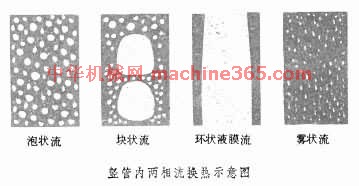1) two-phase flow instability


两相流不稳定性
1.
The steam-water two-phase flow instability in vertical parallel pipes was studied experimentally in the high pressure steam-water test loop.
在高压汽水回路上对垂直并联管中汽液两相流不稳定性进行了试验研究。
2) two-phase flow instabilities


两相流动不稳定性
1.
An experimental investigation on pressure drop oscillation of two-phase flow instabilities was conducted in horizontal helically coiled tube with water as working fluid.
为汽液两相流动不稳定性的进一步研究和螺旋管式热交换器及锅炉反应器的设计、开发提供了依据。
3) two phase flow instability


两相流动稳定性
1.
To test the validity of the theoretical method in analysing two phase flow instability in the thermal dynamic systems, the experimental results on a natural circulation loop have been made use of.
介绍了动力系统的分岔理论的原理及稳定性判别方法,指出热工流体系统的耗散性和非线性因素,最后结合两相自然循环流动稳定性的一个计算实例,将理论计算结果与实验作了比较,两者吻合较好,证明应用分岔理论分析热工流体系统两相流动稳定性是可行的。
4) two phase flow stability


两相流稳定性
1.
Two phase flow pressure drop characteristic is an important parameter in the study of two phase flow stability.
两相流压降特性是两相流稳定性研究中的重要特征参数,不同类型的不稳定有不同的压降特性与之对应。
5) phase instability


相不稳定性
1.
Investigation of phase instability in the binary Gaussian core model;


二元高斯核模型的相不稳定性研究
2.
In this thesis the phase instability of binary Gaussian core model has been investigated with the type of the phase instability be chara.
本文主要研究了描述高分子链二元系统的相不稳定性。
6) Flow instability


流动不稳定性
1.
Research of flow instability in forced-convection generator;


强迫循环下蒸汽发生器流动不稳定性研究
2.
The flow instability in falling films,one of its significant features,was studied by shadowgraphy at different inclination angles to explore the relationship between inclination angle β and other parameters,as well as the effects on the film instabilities.
流动不稳定性是下降液膜流动最重要的特点。
3.
Flow instability of natural circulation under rolling motion condition was studied experimentally in this paper.
分析研究了摇摆运动下的自然循环流动不稳定性和摇摆对不稳定性的类型以及不稳定性起始点的影响。
补充资料:传热学:两相流换热
两相流换热:
自然界中的物质有3种形态﹕固相﹑液相和气相。两相物质共存的流动称为两相流。两相流与管道壁面之间的传热过程称为两相流换热﹐它实际上也是一种对流换热。在工业生產中﹐有各种各样的两相流和两相流换热。例如﹐在化学工业中的流化床内的流动和换热﹐用管道输送粉状和粒状固相物质时的流动和换热﹐气-液(或汽-液)两相流换热等。其中汽-液两相流换热得到广泛而深入的研究﹐因为它是生產中广为使用的蒸汽锅炉﹑蒸汽冷凝设备和核反应堆中传热计算的重要基础知识。两相流换热已发展成为传热学的一个重要分支。
两相流换热与单相流换热的主要区别在於两相分界面的形状对流型和换热过程有重要影响﹐而相分界面的形状又随著含汽率﹑流速和管道放置的方位等条件的变化而改变。例如对於竖管的两相流传热就有4种流态(见图 竖管内两相流换热示意图 )。泡状流﹕当含汽率不大时﹐在连续液体中均匀分布著许多大小不同的小汽泡。块状流﹕当含汽率增高到某一数值时﹐许多小汽泡就汇集成为一个块状的大汽泡﹐其直径接近管道的内径。在大汽泡之间的液体中含有一些均布的小汽泡。环状液膜流﹕当含汽率增高到很高时﹐液相变成沿管壁流动的环状液膜﹐而汽相则居中流动﹐少量液相以细小雾状液珠悬浮在汽相中。雾状流﹕当管壁上的环状液膜被全部蒸发时﹐管内就充满著悬浮雾滴。
竖管内两相流换热示意图 )。泡状流﹕当含汽率不大时﹐在连续液体中均匀分布著许多大小不同的小汽泡。块状流﹕当含汽率增高到某一数值时﹐许多小汽泡就汇集成为一个块状的大汽泡﹐其直径接近管道的内径。在大汽泡之间的液体中含有一些均布的小汽泡。环状液膜流﹕当含汽率增高到很高时﹐液相变成沿管壁流动的环状液膜﹐而汽相则居中流动﹐少量液相以细小雾状液珠悬浮在汽相中。雾状流﹕当管壁上的环状液膜被全部蒸发时﹐管内就充满著悬浮雾滴。
进行两相流换热计算时﹐必须根据不同的流型和含汽率的高低﹐引用相应的经验公式。常见的两相流换热有沸腾换热和凝结换热。
自然界中的物质有3种形态﹕固相﹑液相和气相。两相物质共存的流动称为两相流。两相流与管道壁面之间的传热过程称为两相流换热﹐它实际上也是一种对流换热。在工业生產中﹐有各种各样的两相流和两相流换热。例如﹐在化学工业中的流化床内的流动和换热﹐用管道输送粉状和粒状固相物质时的流动和换热﹐气-液(或汽-液)两相流换热等。其中汽-液两相流换热得到广泛而深入的研究﹐因为它是生產中广为使用的蒸汽锅炉﹑蒸汽冷凝设备和核反应堆中传热计算的重要基础知识。两相流换热已发展成为传热学的一个重要分支。
两相流换热与单相流换热的主要区别在於两相分界面的形状对流型和换热过程有重要影响﹐而相分界面的形状又随著含汽率﹑流速和管道放置的方位等条件的变化而改变。例如对於竖管的两相流传热就有4种流态(见图
 竖管内两相流换热示意图 )。泡状流﹕当含汽率不大时﹐在连续液体中均匀分布著许多大小不同的小汽泡。块状流﹕当含汽率增高到某一数值时﹐许多小汽泡就汇集成为一个块状的大汽泡﹐其直径接近管道的内径。在大汽泡之间的液体中含有一些均布的小汽泡。环状液膜流﹕当含汽率增高到很高时﹐液相变成沿管壁流动的环状液膜﹐而汽相则居中流动﹐少量液相以细小雾状液珠悬浮在汽相中。雾状流﹕当管壁上的环状液膜被全部蒸发时﹐管内就充满著悬浮雾滴。
竖管内两相流换热示意图 )。泡状流﹕当含汽率不大时﹐在连续液体中均匀分布著许多大小不同的小汽泡。块状流﹕当含汽率增高到某一数值时﹐许多小汽泡就汇集成为一个块状的大汽泡﹐其直径接近管道的内径。在大汽泡之间的液体中含有一些均布的小汽泡。环状液膜流﹕当含汽率增高到很高时﹐液相变成沿管壁流动的环状液膜﹐而汽相则居中流动﹐少量液相以细小雾状液珠悬浮在汽相中。雾状流﹕当管壁上的环状液膜被全部蒸发时﹐管内就充满著悬浮雾滴。 进行两相流换热计算时﹐必须根据不同的流型和含汽率的高低﹐引用相应的经验公式。常见的两相流换热有沸腾换热和凝结换热。
说明:补充资料仅用于学习参考,请勿用于其它任何用途。
参考词条